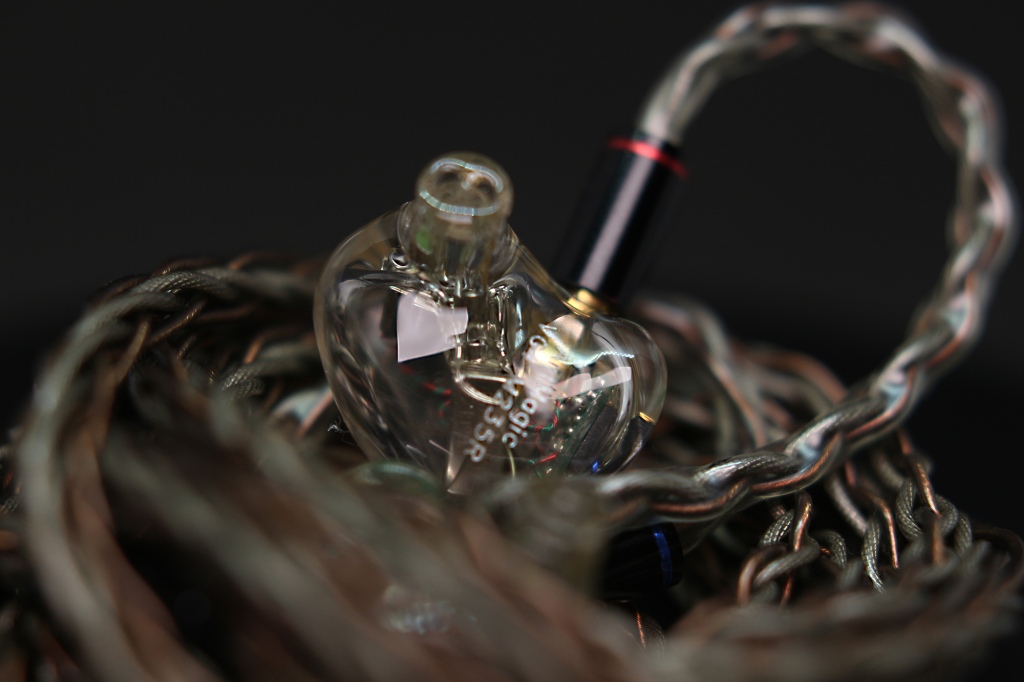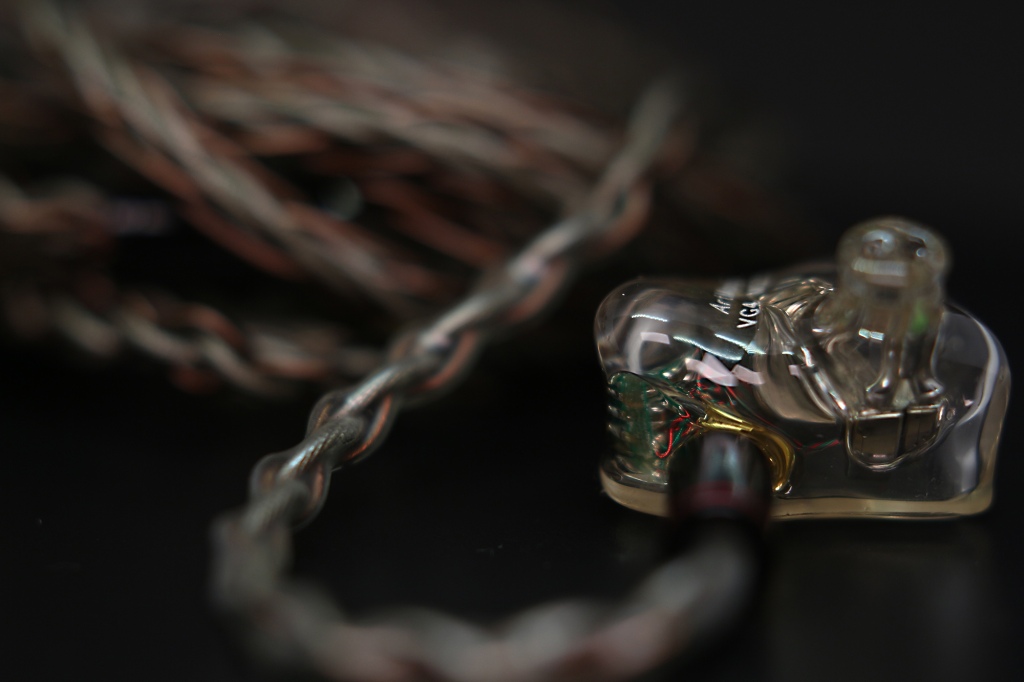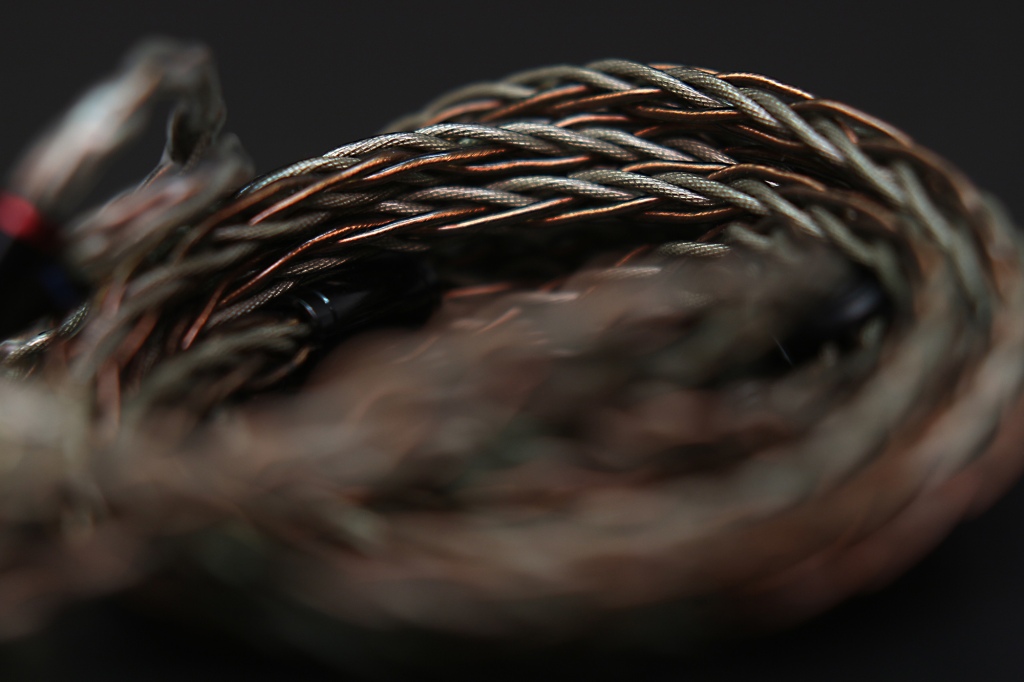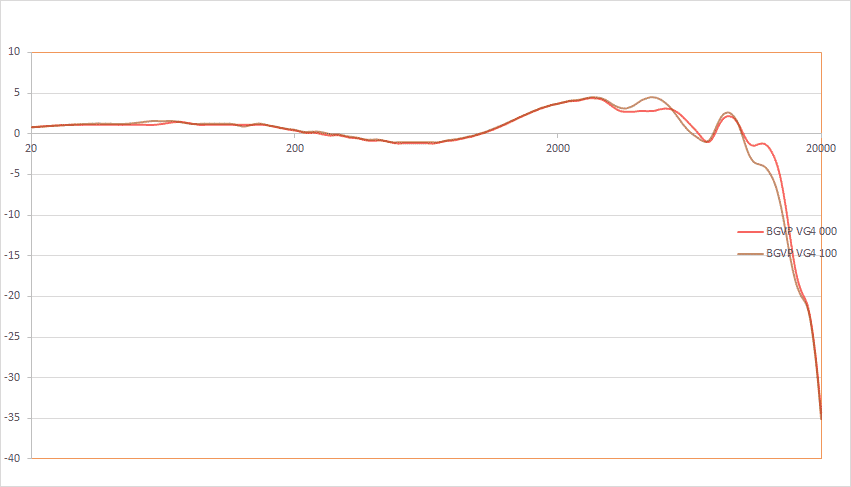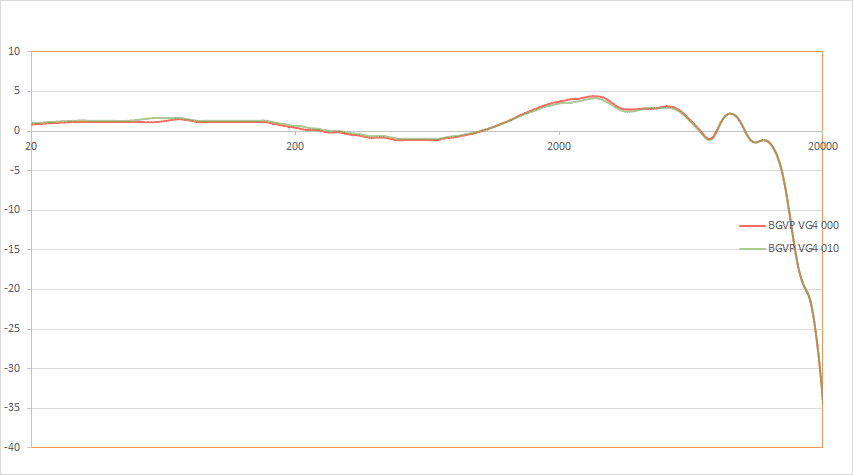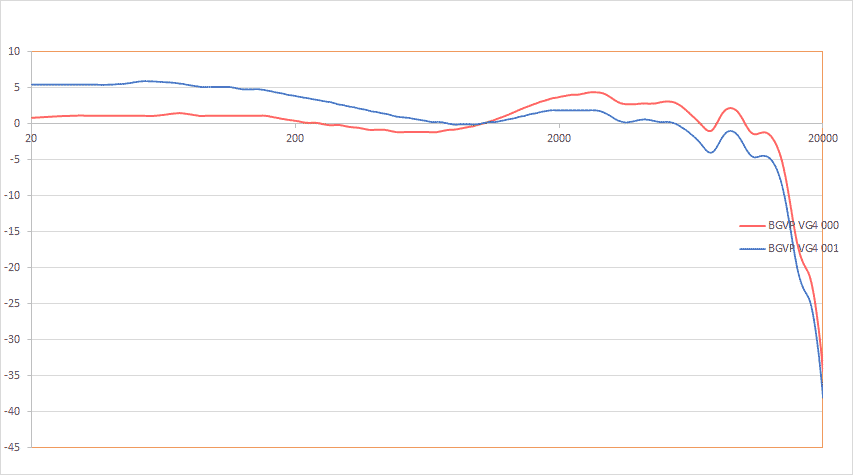Introduction
I have the pleasure of analyzing another great product, the BGVP brand. As I mentioned before, BGVP is originally from China (Dongguan) and has a good catalogue of IEMS and Earbuds. The present model is the ArtMagic VG4: some IEMS Full BA, with 4 drivers per capsule. For this occasion, BGVP has chosen to use a combination of two drivers Sonion and two drivers Knowles. All of them have been integrated in a translucent capsule, made of acrylic fiber resin. Also, a 4-way crossover system has been used to gently mix all the sound generated. As in other models, we have chosen to integrate a mechanism of 3 micro-switches, which allow us to adjust the sound in up to 8 different configurations, capable of satisfying our listening needs. The set comes with a 6N cable, hybrid, with copper and silver strands. The set is completed with the classic packaging, very similar to the one used for the DH3 model. Finally, these IEMS have a high level of customization, being able to choose from more than 12 types of capsules, or make combinations between multiple housings and external plates.
All this will be analyzed in depth, in the following review.



Specifications



Packaging
The VG4 comes in a moderately large box, the dimensions of which are 182x130x53mm. It comes sealed in cellophane, which has two seals of guarantee. The external part of the box, consists of a decorated cardboard cover. The front and back sides are white and the sides are black. On the main face, there is the model name, on the top, together with the brand logo. In the center there are two drawings of the capsules, composed only by the edges of them. On the lower left is the Hi-Res logo and on the right is the Knowles and Sonion logos.
On the back side, there are the specifications, information about the brand and address, the web address, a QR code and the consequent quality certifications. On the sides are the logos of the brand and the information of the model of the capsule. This time, it is a totally transparent capsule.
Once the cardboard is removed, a black, textured box with the letters BGVP in the centre is revealed. After removing the lid, a foam mould can be seen, in which the silicone and foam tips, the capsules and the carrying case are inserted. There is also a white envelope, which contains the guarantee, manuals and quality certificate. Inside the case, there is the cable, whose jack connector is protected by a plastic cover, two pairs of black silicone tips and a cleaning brush. In summary, the contents are as follows:
The content is practically the same, as the DH3 model, appropriate to its price and quality. The case is large and rigid, totally distinctive and the accessories are adequate. Some bi or tri-flange types may be missed, although the morphology of the capsules may not be suitable for this type of tip.
In general and despite being a classic content within the brand, in this section BGVP are maintained at an excellent level and according to their price.



Construction and Design
As usual, the ArtMagic VG4, has been built on German Envision TEC's 3D printing equipment, manufactured using PMMA acrylic fiber. This material is fully skin-friendly, resistant and offers a high degree of impact protection.
The capsules have an ergonomic shape, which is somewhat larger than the DH3 model, though their shapes are similar. The connection is MMCX, gold-plated. The revised model is fully transparent. It has a plate with 3 micro-switches. On the inner side there is an inscription in white letters, which reads "ArtMagic VG4 M236R", on the right capsule and "ArtMagic VG4 M236L", on the left. The external face has the logo, in silver, on the inside. The nozzles are one piece, custom type, with two holes in each one and without grids or filters.
The internal configuration is very similar to the DH3, since it uses the same Knowles BA drivers. On the other hand, for low frequencies, a double Sonion BA driver has been chosen. In summary, the drivers used are: 1 Sonion double BA 33AJ007 (bass), 1 Knowles BA ED-29689 (midrange) and 1 Knowles BA RAF-33518 (treble).
To smooth and mix the curve, the classic 4-way electronic crossover has been integrated.
This time, the number of micro-switches has been increased: there are 3 in each capsule, allowing up to 8 different types of tuning.
The cable is composed of 8 hybrid strands, of copper and silver of 6N. It is thick, rubbery to the touch, but very soft and flexible. It is slightly rough to the touch. The different strands, of copper and silver, are easily distinguishable. The Jack cover is black, metallic and smooth, with a good size. The connector is gold-plated and its diameter is 3.5mm. The dividing piece is a black and metallic barrel. There is a round, black rubber pin with the brand logo inscribed on it. The shape over the ear is given by a slightly rigid, transparent plastic case, which is very pleasant and not very annoying. Finally, the sleeves of the MMCX connectors are black metallic cylinders, with a blue or red ring, to distinguish the channel. The MMCX connectors are gold-plated.
The capsules are perfectly constructed. As they are transparent, you can see the whole interior, how all the drivers are assembled, in a perfect way, almost handmade. The capsules have no defects and are of high quality construction. The cable is very soft and comfortable. Its hybrid aspect is original and only, its more rubbery touch, presents some strange sensation... but this is a personal appreciation, which does not limit its quality, since it is very docile, flexible and not microphonic at all. Very good cable, besides being comfortable and not very heavy.



Adjustment and Ergonomics
The shape is very similar to its brother DH3, but its volume is larger. This does not imply any change in the comfort of the current capsules. Its semi custom shape, fits very well to my morphology, fixing it with great security. With some hybrid tips, filled with foam, I get a high degree of comfort and insulation. Its nozzles are short, approximately 6mm, the same size as its diameter. The insertion is shallow, which is grateful for the use of wider tips. Tri-flange tips could be used, but in this case, the angle could represent some problem, depending on the morphology of our particular ear canal.
The softness and gumminess of the cable, added to the lightness of the cable and the subtle coating on the ear, provides a high degree of comfort. In addition, the microphone is non-existent.
Both elements, capsules and cable, form a great set, whose size, does not penalize neither the comfort, nor the adjustment.



Sound
Profile
The profile of the VG4 can be modified with the switches. Although the greatest enhancement is obtained in the lower zone, its profile is not far from balance, varying towards the warm side. Regardless of the position of the switches, their midrange, the softness and control of the treble, as well as their extension, does not fall.


Switch Positions
1 OFF - 2 OFF - 3 OFF. In short 000: Reference sound, where balance and equilibrium are combined, with a very adequate presence of bass, very juicy mid-range and controlled treble.
1 ON - 2 OFF - 3 OFF. In short mode 100: Slight enhancement of first highs. The sound acquires a little more brilliance and presence, improving in nuances and definition.
1 OFF - 2 ON - 3 OFF. In short 010: Enhancement of the central area. The sound gains in presence, roundness, body and density.
1 OFF - 2 OFF - 1 ON. In short 001: Sensitive enhancement of the lower and middle areas. The sound becomes full and warm. The presence of the bass is evident and is gained in depth and body, acquiring greater density and weight.
The rest of the combinations become more or less adequate mixes, sometimes more diffuse, to which everyone can find the taste or preference.


Bass
Starting from the 000 position, the lower zone remains very linear, with good depth and a neutral and balanced presence. Its control and colour stand out, a priori, in spite of coming from a double BA, its texture is very achieved. The amount of air that moves, is not very large, although its characteristics are very well achieved and exposed. So much so, that when the 001 mode is activated, the bass is widened and enlarged, without losing naturalness, body and sweetness. It is indisputable the quality of this double BA of Sonion, since it is not easy, to determine that the low zone, comes from a full BA. The bass has authority and a strong hit, but dry and tight. Its recovery is high and in the decay, it is possible to distinguish its BA feel, as well as in the texture of the lower part of the sub-bass, which, on the other hand, is the weakest part of the range. The lower part of the sub-bass, suffers from the BA sound and does not manage to reproduce, with all the naturalness and fidelity, the lower end . But, otherwise, the agility, the flatness and the descriptive power of the VG4 makes it one of the best Full BA bass I have ever tested in this price range. It is clear, then, that the level of fun, which is acquired in position 001, makes the rest of the modes a little forgotten. I think I've become a Full BA Bass lover...


Mids
For the middle zone, the switches have many positions. The sound, body and density can vary, depending on how they are activated. Although I prefer the 000, 001 or 010 positions, as they provide a warmth and softness, which helps to generate a more realistic and natural sound, always, in my opinion.
The mids can move from a pleasant neutrality, to rise in a greater exuberance, to end in a full body, a larger, zenithal presence and a fairly full density. All of them enjoy a clarity, already characteristic, that shows the ornamental richness they possess, without losing the naturalness and without presenting any artificiality, sibilance or lack of detail.
Again, the light and the separation, stand out in the central area of this new model of BGVP. Its luminosity brings the voices closer to our ears and the recreation of the characters acquires three-dimensionality, occupying a privileged area within the scene. The integration of all the drivers is very harmonious, since there are no gaps or integration failures between the instruments and voices of that range.
The sonority is natural, it has a warmth, but it is not totally creamy or eminently soft, because its BA profile, comes out, in its capacity of definition and in the recreation of the final details. In this way, its profile finds a balance between neutrality and a light analytical leave, fed by its good level of resolution, definition and perfectionist refinement.
These characteristics make the middle zone highly enjoyable and make it perhaps the best range of the VG4, since it has a great amount of descriptive capacity, a rich, multiple and very adaptable recreation to all genres.


Treble
In this new model, the treble can be modified, by using the switches. In this way, it is possible to gain in presence, without this implying an imbalance, nor any significant alteration within the harmony and naturalness of the whole. The VG4 is characterized by a good extension of treble, with a good amount of air. Their presence is not trimmed, but they have a very detailed profile, with elegant and gentle trebles, without being sharp, nor protruding too much, in the general sound.
By activating the 100 mode, a lively and sparkling sound is achieved, but maintaining a natural and precise color. The detail is maximized in this position and the treble is narrowed, but not sharp. The result is an advantage that allows to offer many more profiles, within the same IEM, ranging from a remarkable presence in the low area, reaching a more explicit profile in the high area.
Even so, in this position, the treble does not bite, despite its clear enhancement, as it is reproduced with great precision and speed. The sound becomes very dynamic and open, at this point, but maintaining a soft and natural feeling in the mids, giving them more clarity, detail, a more concise reproduction, but somewhat less body. On the other hand, it gains in resolution and separation, as they are freed from the higher density offered by other switch positions. The scene, at this point, feels modified, as spatiality is raised, taking the listener away from the stage, providing a relatively different point of view.

Soundstage, Separation
As it could not be otherwise, the switches also affect the scene, being able to modify, almost, to the taste. Although there is no doubt that the VG4 has a remarkable scene, it can even be tuned to the outstanding. In the bass boost mode, the stage looks deep, almost round. The greater body and density bring both the instrumentation and the voices closer to the listener. In the midrange mode, the stage is widened and the area is perceived as more liberated, with more air, expanding the music in width and height. In the mode of greater presence of treble, the greater clarity and better definition, gives the scene more technical planes, gaining in three-dimensionality and increasing the separation.
Overall, the scene continues to be reconstructed from the central range. However, on this occasion, the focus is not so much on the vocalists, but rather the technical improvements imply that there is a greater instrumental role, improving this aspect. On this basis, the stage is drawn from this starting point. Meanwhile, the side bands help the scene to expand in different directions: the bass generates depth and the treble helps to separate the music, to draw a more spherical image. Meanwhile, the midrange stays in that delicious limbo, which the listener doesn't want to leave.

Comparisons
BGVP ArtMagic DH3
One of the obligatory comparisons is with his younger brother, the DH3, who has brought me so much joy. There are many similarities between the two, as both models use the same Knowles BA drivers, for mid and high. The shape of the capsules is similar, being slightly thicker those of the VG4. Both have microswitches, two the DH3, three the VG4. The cable is very similar, but in the VG4 it is thicker, more comfortable and flexible, an improvement. Both the packaging and the accessories are practically the same.
As for the sound differences, it is assumed that the DH3 has a dynamic driver for the low zone and the VG4 has a double Sonion BA. This configuration gives a better performance to the new model, being more sensitive and easy to move.
The first sensation that can be appreciated, between both models, is clearly the impression produced by the low zone. In the DH3, the dynamic driver has more influence on the rest of the ranges, while in the VG4, the sound flows cleaner, freer and more precise, gaining in clarity and resolution, something that the mids, highs and details appreciate. The DH3's bass is darker and heavier, and also slower. It is true that the sub-bass appreciates the dynamic driver, but the execution weighs down the dynamism of the area, being less agile and recovering more slowly, leaving a darker and warmer pose, with a heavier and dustier texture. Meanwhile, the VG4, feel vivid, elastic, graceful and dynamic. Their recovery is faster, there is more light and separation between the lower notes, a more cheerful colour, greater descriptive power and resolution. It is clear that the VG4's hitting is not as noticeable as that produced by the DH3's, nor are the sub-bass notes reproduced as real and pleasant, but their quality improves overall to the sound.
In the middle zone, changes are also observed, more than could be expected a priori. Starting with the voices, in the VG4, their projection is even clearer, more vivid and isolated. They have more definition and feel less mixed. In addition, they have more nuances and details, offering even more emotion and enthusiasm. In DH3, voices sound warmer and softer, with less ornamentation, wider and less resolution. Something similar happens with the instruments, where the VG4 are able to provide a greater weight to each note, while the DH3 are more limp, less decisive and with less definition and micro details. But, the clear difference between both models, in this range, is in the texture and timbre. The former proves to be more refined, accurate and realistic, with better detail, descriptiveness and fidelity. The second, the timbre, is sweeter, clearer, natural and faithful.
In the upper zone, the VG4 demonstrates its quality, not only because it has a dedicated and exclusive position, but also because its presence and extension is superior. It seems unbelievable, as BGVP, they have improved the treble, using the same drivers. In the 100 mode, the extension, presence, amount of detail and definition, overwhelms by comparison. The DH3 has a softer character in this range, while the VG4, even in its 000 mode, draws a more natural and less clipped area, showing off its better reproduction and extension.
At scene level, the VG4's greater separation and amount of air expands the image in various directions. The switches are able to control this expansion. While in the DH3, something similar happens, but with a more limited effect. The better and greater presence of treble, the more contained low zone, the greater definition and resolution of the mids, generates an expanded and large scene in the VG4, with that extra clarity, separation and a darker background, which offers a qualitative leap.
In short, the VG4 improves in almost every aspect to the DH3, except for the sub-bass, which sounds more faithful and natural, in the little brother.
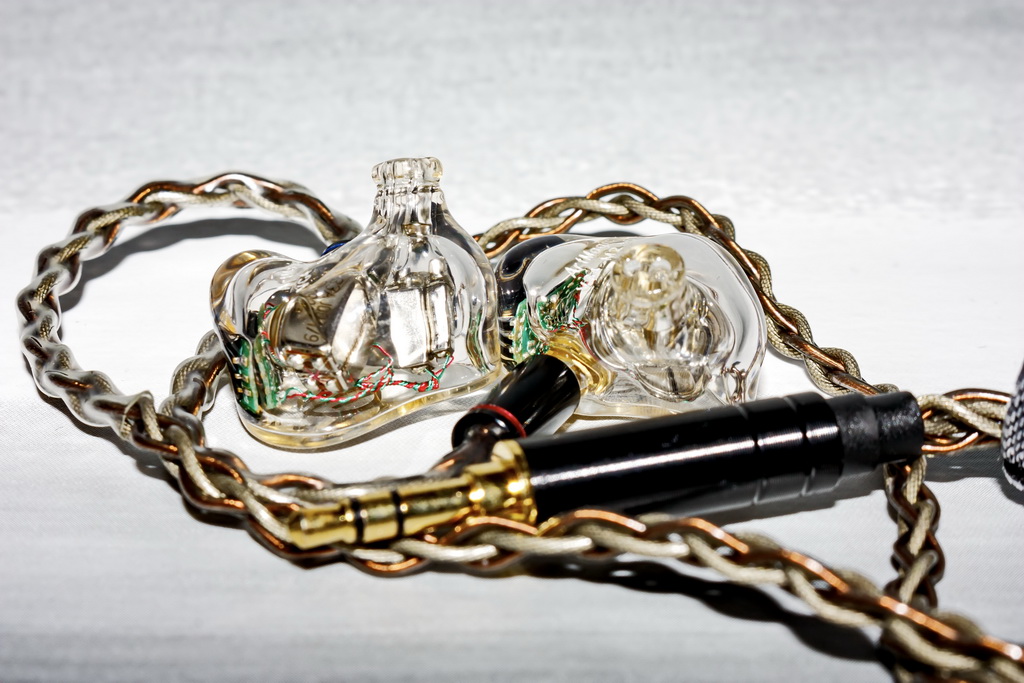
Conclusion
BGVP has achieved it again, they have surpassed my beloved DH3, making a new model that, starting from the same base, has known how to squeeze the potential of the used drivers, adding a new one, to the lower zone. For this they have chosen a full BA configuration and they have not made a mistake. They have expanded the tuning possibilities, adding a micro switch, offering a greater sound versatility, extending the high zone and even improving the middle zone, starting from a double Sonion BA, for bass, which provides a lot of quality to the low zone. The new VG4 is a great buy for its price. They are very adaptable, comfortable, its cable is better and its sound has improved, both in dynamism, tuning, extension, scene, clarity, presence, resolution, timbre, naturalness, detail and resolution. Excellent!
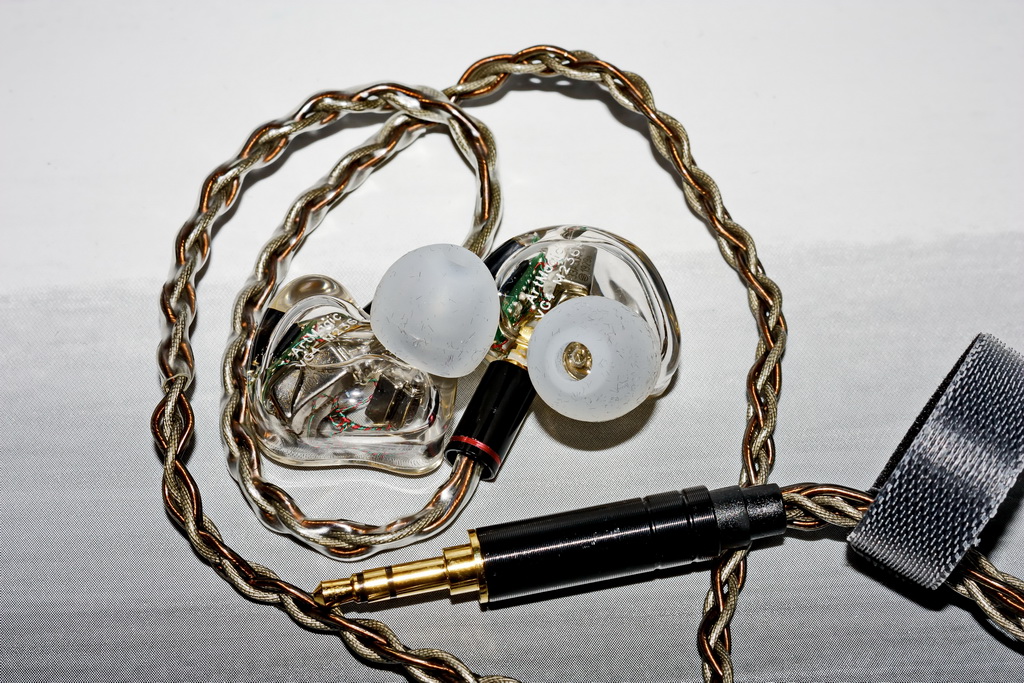
Sources Used During the Analysis

Ratings
Purchase link
https://es.aliexpress.com/item/4000166039379.html
You can read the full review in Spanish here:
https://hiendportable.com/2020/07/04/bgvp-artmagic-vg4-review/
I have the pleasure of analyzing another great product, the BGVP brand. As I mentioned before, BGVP is originally from China (Dongguan) and has a good catalogue of IEMS and Earbuds. The present model is the ArtMagic VG4: some IEMS Full BA, with 4 drivers per capsule. For this occasion, BGVP has chosen to use a combination of two drivers Sonion and two drivers Knowles. All of them have been integrated in a translucent capsule, made of acrylic fiber resin. Also, a 4-way crossover system has been used to gently mix all the sound generated. As in other models, we have chosen to integrate a mechanism of 3 micro-switches, which allow us to adjust the sound in up to 8 different configurations, capable of satisfying our listening needs. The set comes with a 6N cable, hybrid, with copper and silver strands. The set is completed with the classic packaging, very similar to the one used for the DH3 model. Finally, these IEMS have a high level of customization, being able to choose from more than 12 types of capsules, or make combinations between multiple housings and external plates.
All this will be analyzed in depth, in the following review.



Specifications
- Drivers type: 4 BA drivers, 1 double BA Sonion 33AJ007 (bass), 1 BA Knowles ED-29689 (midrange) and 1 BA Knowles RAF-33518 (treble).
- Frequency Response: 10Hz - 40kHz
- Sensitivity: ≥ 110dB SPL/MW
- Impedance: 12Ω
- Channel Difference: ≤ 1dB
- THD: 0.5% (1kHz)
- Nominal power 8mW
- Connector Jack: 3.5mm
- Cable length: 1.2m ± 5%.
- Capsule Connection Type: MMCX
- Weight: about 4.2g each capsule.



Packaging
The VG4 comes in a moderately large box, the dimensions of which are 182x130x53mm. It comes sealed in cellophane, which has two seals of guarantee. The external part of the box, consists of a decorated cardboard cover. The front and back sides are white and the sides are black. On the main face, there is the model name, on the top, together with the brand logo. In the center there are two drawings of the capsules, composed only by the edges of them. On the lower left is the Hi-Res logo and on the right is the Knowles and Sonion logos.
On the back side, there are the specifications, information about the brand and address, the web address, a QR code and the consequent quality certifications. On the sides are the logos of the brand and the information of the model of the capsule. This time, it is a totally transparent capsule.
Once the cardboard is removed, a black, textured box with the letters BGVP in the centre is revealed. After removing the lid, a foam mould can be seen, in which the silicone and foam tips, the capsules and the carrying case are inserted. There is also a white envelope, which contains the guarantee, manuals and quality certificate. Inside the case, there is the cable, whose jack connector is protected by a plastic cover, two pairs of black silicone tips and a cleaning brush. In summary, the contents are as follows:
- The capsules.
- 3 pairs of blue tips, size SxMxL, Vocal ear tips.
- 3 pairs of white tips, sizes SxMxL, Bass ear tips.
- 3 pairs of black tips, sizes SxMxL.
- 1 pair of foam tips, size medium
- 1 hybrid cable, 8 strands of 6N, with MMCX connectors
- A cleaning brush.
- A carrying case.
- Manual, certificate of guarantee, quality control and recommendations for use.
The content is practically the same, as the DH3 model, appropriate to its price and quality. The case is large and rigid, totally distinctive and the accessories are adequate. Some bi or tri-flange types may be missed, although the morphology of the capsules may not be suitable for this type of tip.
In general and despite being a classic content within the brand, in this section BGVP are maintained at an excellent level and according to their price.



Construction and Design
As usual, the ArtMagic VG4, has been built on German Envision TEC's 3D printing equipment, manufactured using PMMA acrylic fiber. This material is fully skin-friendly, resistant and offers a high degree of impact protection.
The capsules have an ergonomic shape, which is somewhat larger than the DH3 model, though their shapes are similar. The connection is MMCX, gold-plated. The revised model is fully transparent. It has a plate with 3 micro-switches. On the inner side there is an inscription in white letters, which reads "ArtMagic VG4 M236R", on the right capsule and "ArtMagic VG4 M236L", on the left. The external face has the logo, in silver, on the inside. The nozzles are one piece, custom type, with two holes in each one and without grids or filters.
The internal configuration is very similar to the DH3, since it uses the same Knowles BA drivers. On the other hand, for low frequencies, a double Sonion BA driver has been chosen. In summary, the drivers used are: 1 Sonion double BA 33AJ007 (bass), 1 Knowles BA ED-29689 (midrange) and 1 Knowles BA RAF-33518 (treble).
To smooth and mix the curve, the classic 4-way electronic crossover has been integrated.
This time, the number of micro-switches has been increased: there are 3 in each capsule, allowing up to 8 different types of tuning.
The cable is composed of 8 hybrid strands, of copper and silver of 6N. It is thick, rubbery to the touch, but very soft and flexible. It is slightly rough to the touch. The different strands, of copper and silver, are easily distinguishable. The Jack cover is black, metallic and smooth, with a good size. The connector is gold-plated and its diameter is 3.5mm. The dividing piece is a black and metallic barrel. There is a round, black rubber pin with the brand logo inscribed on it. The shape over the ear is given by a slightly rigid, transparent plastic case, which is very pleasant and not very annoying. Finally, the sleeves of the MMCX connectors are black metallic cylinders, with a blue or red ring, to distinguish the channel. The MMCX connectors are gold-plated.
The capsules are perfectly constructed. As they are transparent, you can see the whole interior, how all the drivers are assembled, in a perfect way, almost handmade. The capsules have no defects and are of high quality construction. The cable is very soft and comfortable. Its hybrid aspect is original and only, its more rubbery touch, presents some strange sensation... but this is a personal appreciation, which does not limit its quality, since it is very docile, flexible and not microphonic at all. Very good cable, besides being comfortable and not very heavy.



Adjustment and Ergonomics
The shape is very similar to its brother DH3, but its volume is larger. This does not imply any change in the comfort of the current capsules. Its semi custom shape, fits very well to my morphology, fixing it with great security. With some hybrid tips, filled with foam, I get a high degree of comfort and insulation. Its nozzles are short, approximately 6mm, the same size as its diameter. The insertion is shallow, which is grateful for the use of wider tips. Tri-flange tips could be used, but in this case, the angle could represent some problem, depending on the morphology of our particular ear canal.
The softness and gumminess of the cable, added to the lightness of the cable and the subtle coating on the ear, provides a high degree of comfort. In addition, the microphone is non-existent.
Both elements, capsules and cable, form a great set, whose size, does not penalize neither the comfort, nor the adjustment.



Sound
Profile
The profile of the VG4 can be modified with the switches. Although the greatest enhancement is obtained in the lower zone, its profile is not far from balance, varying towards the warm side. Regardless of the position of the switches, their midrange, the softness and control of the treble, as well as their extension, does not fall.


Switch Positions
1 OFF - 2 OFF - 3 OFF. In short 000: Reference sound, where balance and equilibrium are combined, with a very adequate presence of bass, very juicy mid-range and controlled treble.
1 ON - 2 OFF - 3 OFF. In short mode 100: Slight enhancement of first highs. The sound acquires a little more brilliance and presence, improving in nuances and definition.
1 OFF - 2 ON - 3 OFF. In short 010: Enhancement of the central area. The sound gains in presence, roundness, body and density.
1 OFF - 2 OFF - 1 ON. In short 001: Sensitive enhancement of the lower and middle areas. The sound becomes full and warm. The presence of the bass is evident and is gained in depth and body, acquiring greater density and weight.
The rest of the combinations become more or less adequate mixes, sometimes more diffuse, to which everyone can find the taste or preference.


Bass
Starting from the 000 position, the lower zone remains very linear, with good depth and a neutral and balanced presence. Its control and colour stand out, a priori, in spite of coming from a double BA, its texture is very achieved. The amount of air that moves, is not very large, although its characteristics are very well achieved and exposed. So much so, that when the 001 mode is activated, the bass is widened and enlarged, without losing naturalness, body and sweetness. It is indisputable the quality of this double BA of Sonion, since it is not easy, to determine that the low zone, comes from a full BA. The bass has authority and a strong hit, but dry and tight. Its recovery is high and in the decay, it is possible to distinguish its BA feel, as well as in the texture of the lower part of the sub-bass, which, on the other hand, is the weakest part of the range. The lower part of the sub-bass, suffers from the BA sound and does not manage to reproduce, with all the naturalness and fidelity, the lower end . But, otherwise, the agility, the flatness and the descriptive power of the VG4 makes it one of the best Full BA bass I have ever tested in this price range. It is clear, then, that the level of fun, which is acquired in position 001, makes the rest of the modes a little forgotten. I think I've become a Full BA Bass lover...


Mids
For the middle zone, the switches have many positions. The sound, body and density can vary, depending on how they are activated. Although I prefer the 000, 001 or 010 positions, as they provide a warmth and softness, which helps to generate a more realistic and natural sound, always, in my opinion.
The mids can move from a pleasant neutrality, to rise in a greater exuberance, to end in a full body, a larger, zenithal presence and a fairly full density. All of them enjoy a clarity, already characteristic, that shows the ornamental richness they possess, without losing the naturalness and without presenting any artificiality, sibilance or lack of detail.
Again, the light and the separation, stand out in the central area of this new model of BGVP. Its luminosity brings the voices closer to our ears and the recreation of the characters acquires three-dimensionality, occupying a privileged area within the scene. The integration of all the drivers is very harmonious, since there are no gaps or integration failures between the instruments and voices of that range.
The sonority is natural, it has a warmth, but it is not totally creamy or eminently soft, because its BA profile, comes out, in its capacity of definition and in the recreation of the final details. In this way, its profile finds a balance between neutrality and a light analytical leave, fed by its good level of resolution, definition and perfectionist refinement.
These characteristics make the middle zone highly enjoyable and make it perhaps the best range of the VG4, since it has a great amount of descriptive capacity, a rich, multiple and very adaptable recreation to all genres.


Treble
In this new model, the treble can be modified, by using the switches. In this way, it is possible to gain in presence, without this implying an imbalance, nor any significant alteration within the harmony and naturalness of the whole. The VG4 is characterized by a good extension of treble, with a good amount of air. Their presence is not trimmed, but they have a very detailed profile, with elegant and gentle trebles, without being sharp, nor protruding too much, in the general sound.
By activating the 100 mode, a lively and sparkling sound is achieved, but maintaining a natural and precise color. The detail is maximized in this position and the treble is narrowed, but not sharp. The result is an advantage that allows to offer many more profiles, within the same IEM, ranging from a remarkable presence in the low area, reaching a more explicit profile in the high area.
Even so, in this position, the treble does not bite, despite its clear enhancement, as it is reproduced with great precision and speed. The sound becomes very dynamic and open, at this point, but maintaining a soft and natural feeling in the mids, giving them more clarity, detail, a more concise reproduction, but somewhat less body. On the other hand, it gains in resolution and separation, as they are freed from the higher density offered by other switch positions. The scene, at this point, feels modified, as spatiality is raised, taking the listener away from the stage, providing a relatively different point of view.

Soundstage, Separation
As it could not be otherwise, the switches also affect the scene, being able to modify, almost, to the taste. Although there is no doubt that the VG4 has a remarkable scene, it can even be tuned to the outstanding. In the bass boost mode, the stage looks deep, almost round. The greater body and density bring both the instrumentation and the voices closer to the listener. In the midrange mode, the stage is widened and the area is perceived as more liberated, with more air, expanding the music in width and height. In the mode of greater presence of treble, the greater clarity and better definition, gives the scene more technical planes, gaining in three-dimensionality and increasing the separation.
Overall, the scene continues to be reconstructed from the central range. However, on this occasion, the focus is not so much on the vocalists, but rather the technical improvements imply that there is a greater instrumental role, improving this aspect. On this basis, the stage is drawn from this starting point. Meanwhile, the side bands help the scene to expand in different directions: the bass generates depth and the treble helps to separate the music, to draw a more spherical image. Meanwhile, the midrange stays in that delicious limbo, which the listener doesn't want to leave.

Comparisons
BGVP ArtMagic DH3
One of the obligatory comparisons is with his younger brother, the DH3, who has brought me so much joy. There are many similarities between the two, as both models use the same Knowles BA drivers, for mid and high. The shape of the capsules is similar, being slightly thicker those of the VG4. Both have microswitches, two the DH3, three the VG4. The cable is very similar, but in the VG4 it is thicker, more comfortable and flexible, an improvement. Both the packaging and the accessories are practically the same.
As for the sound differences, it is assumed that the DH3 has a dynamic driver for the low zone and the VG4 has a double Sonion BA. This configuration gives a better performance to the new model, being more sensitive and easy to move.
The first sensation that can be appreciated, between both models, is clearly the impression produced by the low zone. In the DH3, the dynamic driver has more influence on the rest of the ranges, while in the VG4, the sound flows cleaner, freer and more precise, gaining in clarity and resolution, something that the mids, highs and details appreciate. The DH3's bass is darker and heavier, and also slower. It is true that the sub-bass appreciates the dynamic driver, but the execution weighs down the dynamism of the area, being less agile and recovering more slowly, leaving a darker and warmer pose, with a heavier and dustier texture. Meanwhile, the VG4, feel vivid, elastic, graceful and dynamic. Their recovery is faster, there is more light and separation between the lower notes, a more cheerful colour, greater descriptive power and resolution. It is clear that the VG4's hitting is not as noticeable as that produced by the DH3's, nor are the sub-bass notes reproduced as real and pleasant, but their quality improves overall to the sound.
In the middle zone, changes are also observed, more than could be expected a priori. Starting with the voices, in the VG4, their projection is even clearer, more vivid and isolated. They have more definition and feel less mixed. In addition, they have more nuances and details, offering even more emotion and enthusiasm. In DH3, voices sound warmer and softer, with less ornamentation, wider and less resolution. Something similar happens with the instruments, where the VG4 are able to provide a greater weight to each note, while the DH3 are more limp, less decisive and with less definition and micro details. But, the clear difference between both models, in this range, is in the texture and timbre. The former proves to be more refined, accurate and realistic, with better detail, descriptiveness and fidelity. The second, the timbre, is sweeter, clearer, natural and faithful.
In the upper zone, the VG4 demonstrates its quality, not only because it has a dedicated and exclusive position, but also because its presence and extension is superior. It seems unbelievable, as BGVP, they have improved the treble, using the same drivers. In the 100 mode, the extension, presence, amount of detail and definition, overwhelms by comparison. The DH3 has a softer character in this range, while the VG4, even in its 000 mode, draws a more natural and less clipped area, showing off its better reproduction and extension.
At scene level, the VG4's greater separation and amount of air expands the image in various directions. The switches are able to control this expansion. While in the DH3, something similar happens, but with a more limited effect. The better and greater presence of treble, the more contained low zone, the greater definition and resolution of the mids, generates an expanded and large scene in the VG4, with that extra clarity, separation and a darker background, which offers a qualitative leap.
In short, the VG4 improves in almost every aspect to the DH3, except for the sub-bass, which sounds more faithful and natural, in the little brother.

Conclusion
BGVP has achieved it again, they have surpassed my beloved DH3, making a new model that, starting from the same base, has known how to squeeze the potential of the used drivers, adding a new one, to the lower zone. For this they have chosen a full BA configuration and they have not made a mistake. They have expanded the tuning possibilities, adding a micro switch, offering a greater sound versatility, extending the high zone and even improving the middle zone, starting from a double Sonion BA, for bass, which provides a lot of quality to the low zone. The new VG4 is a great buy for its price. They are very adaptable, comfortable, its cable is better and its sound has improved, both in dynamism, tuning, extension, scene, clarity, presence, resolution, timbre, naturalness, detail and resolution. Excellent!

Sources Used During the Analysis
- Burson Audio Playmate
- HiBy R3 Pro.
- JWD JWM-115 Review

Ratings
- Construction and Design: 92
- Adjustment/Ergonomics: 80
- Accessories: 91
- Bass: 86
- Mids: 93
- Treble: 90
- Separation: 92
- Soundstage: 92
- Quality/Price: 93
Purchase link
https://es.aliexpress.com/item/4000166039379.html
You can read the full review in Spanish here:
https://hiendportable.com/2020/07/04/bgvp-artmagic-vg4-review/











